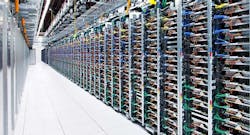Google used 5.7 Terawatt hours of energy in 2015, according to Joe Kava, who heads the company’s global infrastructure “Data centers make up the vast majority of that,” said Kava, which is why Google has also taken a leadership position in procuring renewable energy for its cloud campuses.
Kava discussed Google’s energy consumption during a keynote at the DCD Enterprise conference in New York, where he joined with executives from Microsoft, Uber and Bloom Energy to discuss the outlook for renewable energy in data centers.
How much is 5.7 terawatt hours a year? It’s almost as much as the entire city of San Francisco, said Kava, the Vice President of Data Centers at Google. To provide some context, 5.7 annual terawatt hours equates to full-time, around the clock operation of about 650 megawatts of energy load.
That wouldn’t be surprising given the scale of Google’s infrastructure, which include cloud campuses in 13 locations around the world, most of which house multiple data centers. The number is certainly higher now, as Google has aggressively added new data center capacity throughout 2016 and early 2017.
2.6 Gigawatts of Renewables
Kava’s disclosure was in service of a larger point: With great power use, comes great responsibility. Google has taken a leadership position in procuring renewable energy to power its data centers, lining up power purchase agreements (PPAs) totaling more than 2.6 gigawatts of wind and solar energy capacity.
“This makes us the world’s largest buyer of renewable energy,” said Kava, who noted that these PPAs have matched 100 percent of Google’s global energy consumption, including its data centers. Because wind and solar are intermittent energy generation sources, the total procurement is in excess of Google’s total data center capacity.
Google’s Joe Kava speaks at DCD Enterprise in New York. (Image: DataCenterDynamics)
Kava said huge cloud operators like Google have a responsibility to use their buying power to drive changes in the U.S. utility industry, which should boost its mix of renewables and make clean energy available to more customers.
“We believe the science of climate change is irrefutable,” said Kava. “We want to provide the utility business model to to deliver what consumers want to buy. It’s clear to me that corporate consumers are interested in buying renewable energy. We’ve been trying to drive the industry forward with work on policy.”
Those efforts are starting to make a difference, as more providers seek access to renewables. In 2016, data center providers signed contracts for more than 1.2 gigawatts of renewable power, marking a dramatic turnaround from earlier headlines critiquing the industry’s dependence upon coal power.
Many of these purchases by hyperscale data center providers have created new production of clean energy, as opposed to credits for use of clean energy from existing sources. This “additionality” is a key strategic priority for Google and several other large cloud customers, who want their investments to support a longer-term shift away from fossil fuel.
Reinsurance As A Renewable Enabler
Making renewable energy work at scale often requires innovative approaches, according to Christian Belady, General Manager of Cloud Infrastructure Strategy at Microsoft, which is also a huge purchaser of renewable energy. Microsoft data centers currently get about 44 percent of their power from wind, solar and hydro electricity, and expect to boost that to 50 percent within two years.
Navigating the energy markets can be tricky, even as the data center industry has emerged as one of the leading players in renewable power.
“There tends to be a significant (price) premium with renewable projects,” Belady said. “There’s a lot of risk associated with that, and these are long-term contracts. How do you manage risk around pricing and production to mitigate that premium?”
In its recent deal to purchase wind energy from the Bloom Wind Project in Kansas, Microsoft used a new strategy to offload some of its risk. “We introduced a reinsurance market,” said Belady.
Reinsurance is typically used to protect insurers from catastrophic risks that require large payouts, such as hurricanes. Companies can hedge their risk by paying premiums to protect against losses beyond a certain threshold, with the reinsurer assuming risk beyond that amount. The arrangement creates predictable costs for the buyer, and income to the seller, who is wagering that its premium revenues will offset losses in a majority of scenarios.
Belady said contracts for renewable energy can help reinsurers diversify their investments and risk portfolio. Here’s a slide from his presentation offering an overview:
“We’re hoping that this will enable others to do similar types of projects,” said Belady. “Cloud providers, because of the scale we’re working at, can introduce ways of doing things differently. That can change the industry and have huge benefits for everyone.”
“There’s a lot more work to be done,” added Kava. “Ultimately, we want a 100 percent renewable grid for everyone.”
About the Author



